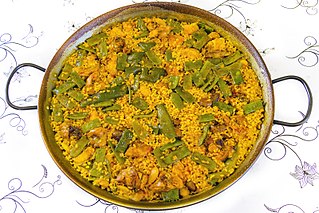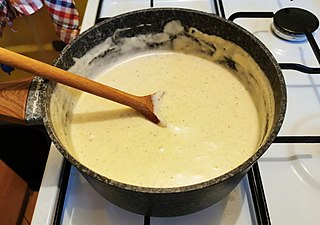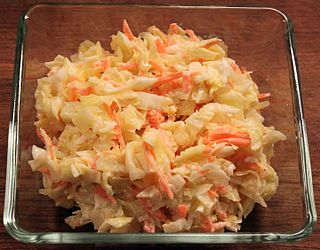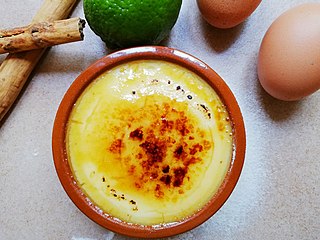Related Research Articles

Paella is a rice dish originally from Valencia. While non-Spaniards commonly view it as Spain's national dish, Spaniards almost unanimously consider it to be a dish from the Valencian region. Valencians, in turn, regard paella as one of their identifying symbols. It is one of the best-known dishes in Spanish cuisine.

Mayonnaise, colloquially referred to as "mayo", is a thick, cold, and creamy sauce commonly used on sandwiches, hamburgers, composed salads, and French fries. It also forms the base for various other sauces, such as tartar sauce, fry sauce, remoulade, salsa golf, and rouille.

Catalan cuisine is the cuisine from Catalonia. It may also refer to the shared cuisine of Northern Catalonia and Andorra, the second of which has a similar cuisine to that of the neighbouring Alt Urgell and Cerdanya comarques and which is often referred to as "Catalan mountain cuisine". It is considered a part of western Mediterranean cuisine.

Mató is a fresh cheese of Catalonia made from sheep' or goats' milk, with no salt added.

Lasagna is a type of pasta, possibly one of the oldest types, made of very wide, flat sheets. Either term can also refer to an Italian dish made of stacked layers of lasagna alternating with fillings such as ragù, béchamel sauce, vegetables, cheeses, and seasonings and spices. The dish may be topped with grated cheese, which becomes melted during baking. Typically cooked pasta is assembled with the other ingredients and then baked in an oven. The resulting baked pasta is cut into single-serving square or rectangular portions.

Halva is a type of confectionery originating from Persia and widely spread throughout the Middle East and India. The name is used for a broad variety of recipes, generally a thick paste made from flour, butter, liquid oil, saffron, rosewater, milk, cocoa powder, and sweetened with sugar.

Salsa is a variety of sauces used as condiments for tacos and other Mexican and Mexican-American foods, and as dips for tortilla chips. They may be raw or cooked, and are generally served at room temperature.

An empanada is a type of baked or fried turnover consisting of pastry and filling, common in Spanish, other Southern European, Latin American, and Iberian-influenced cultures around the world. The name comes from the Spanish empanar, and translates as 'breaded', that is, wrapped or coated in bread. They are made by folding dough over a filling, which may consist of meat, cheese, tomato, corn, or other ingredients, and then cooking the resulting turnover, either by baking or frying.

Béchamel sauce is one of the "mother sauces" of French cuisine.

Coleslaw, also known as cole slaw, or simply as slaw, is a side dish consisting primarily of finely shredded raw cabbage with a salad dressing or condiment, commonly either vinaigrette or mayonnaise. This dish originated in the Netherlands in the 18th century. Coleslaw prepared with vinaigrette may benefit from the long lifespan granted by pickling.

Deviled eggs are hard-boiled eggs that have been shelled, cut in half, and filled with a paste made from the egg yolks mixed with other ingredients such as mayonnaise and mustard. They are generally served cold as a side dish, appetizer or a main course during gatherings or parties. The dish's origin can be seen in recipes for boiled, seasoned eggs as far back as ancient Rome, where they were traditionally served as a first course. The dish is popular in Europe, North America and Australia.

The dessert known in most of Spain as crema catalana, but as crema cremada in Catalan cuisine, is similar to a crème brûlée; the desserts have been called "virtually identical", although crema catalana is made with milk, while crème brûlée is made with cream. Crema catalana is a custard made from egg yolks, milk, sugar, cornflour, and aromatics, typically lemon zest, cinnamon, or vanilla, with a crisp caramel crust.

Hippocras, sometimes spelled hipocras or hypocras, is a drink made from wine mixed with sugar and spices, usually including cinnamon, and possibly heated. After steeping the spices in the sweetened wine for a day, the spices are strained out through a conical cloth filter bag called a manicum hippocraticum or Hippocratic sleeve, from which the name of the drink is derived.

Picada is one of the characteristic sauces and culinary techniques essential to Catalan cuisine. The technique is typically found in Catalonia and Valencia and subsequently Catalan cuisine and Valencian cuisine. It is not an autonomous sauce like mayonnaise or romesco, but it is added as a seasoning during the cooking of a recipe.
Powder-douce is a spice mix used in Medieval and Renaissance cookery. Like modern spice mixes such as "Italian seasoning," "garam masala," "taco seasoning," etc., there was not a set ingredient list, it varied from cook to cook. The author of the 14th-century manuscript Le Ménagier de Paris suggested a mix of grains of paradise, ginger, cinnamon, nutmeg, sugar, and galangal.
Robert de Nola, also known by pseudonym Mestre Robert, was a Spanish chef who authored the first printed cookbook in Catalan language, Llibre del Coch. He served as cook to King of Naples Ferdinand I.

Sharbat is a drink prepared from fruit or flower petals. It is a sweet cordial, and usually served chilled. It can be served in concentrated form and eaten with a spoon or diluted with water to create the drink.

Almadroc is a garlic-cheese sauce from medieval Catalan cuisine from the Llibre de Sent Soví. There is a similar recipe in the Llibre del Coch by Rupert de Nola for almadrote, a similar recipe for a sauce made with garlic, eggs, cheese and broth that was served with partridge. In modern usage it refers to an oil, garlic and cheese sauce served with eggplant casserole. Almadrote may have pre-Inquisition Sephardic origins and served with eggplant has become widespread in modern Turkish cuisine.

The Llibre del Coch, or Llibre de doctrina per a ben servir, de tallar y del art de coch cs de qualsevol manera, potatges y salses compost per lo diligent mestre Robert coch del Serenissimo senyor Don Ferrando Rey de Napols, is a Catalan recipe book written around 1490 by Master Robert de Nola. Its earliest preserved printed edition is from 1520, published in Catalan in Barcelona. It includes mainly recipes from the Catalan cuisine of the time, some of them inherited from the Llibre de Sent Soví, and some from neighboring countries, such as the Occitan cuisine and the Italian cuisine, including traditions from different areas dominated by the Crown of Aragon, which at that time was spread to the northeastern Mediterranean, Southern Italy, Corsica and Sicily. Despite not including Castilian recipes, was also very successful in Castile, was translated into Spanish in 1525 and republished in this language several times. It is considered of great value for acquiring a good knowledge about the gastronomy of the Renaissance.
References
- ↑ Pedralbes. Universidad de Barcelona.
- ↑ "Pollastre o capó rostit amb salsa de pagó". Fundació Institut Català de la Cuina.
- ↑ Food in Motion The Migration of Foodstuffs and Cookery Techniques : Proceedings : Oxford Symposium. Oxford Symposium. 1983. ISBN 9780907325154.